My ultimate aim to achieve “Zero death in Elevator Accidents” has prompted me to take up the above topic for my research work.
My interest in studying every accident report, analyzing it to understand the root cause of the accident, and consolidating it has helped me to take up the above issue.
This study will help Elevator Industry and Government authorities to take the required corrective measures.
Elevator accidents and passenger deaths are major concerns for all Elevator Manufacturers, Service Providers, and Government Agencies.
The number of elevator installations in India is increasing year after year. Thanks to the change in Government policies and regular improvement in the safety systems and procedures which helps users to enjoy safe travel.
As per the data available, the elevator requirement in India around the year 2010 was nearly 30,000 units which has gone up to 85,000 units in the year 2022. The total number of installed elevators in the country by 2022 have crossed 7,00,000 units.
The regular increase in the number of elevator installations demanded a proportionate increase in safety monitoring systems by the controlling authorities.
The increase in the number of elevator accidents and passenger deaths has prompted me to study and understand the root cause of the failure and to come up with possible solutions/ suggestions that can help in controlling and reducing the number of accidents and passenger deaths.
To study the reasons behind the elevator accidents I have collected accident data for the period January 2019 to December 2022. I already had accident data for the period from January 2009 to December 2012. which helped me a lot in understanding the issue in depth.
To study the reasons behind the elevator accidents I have collected accident data for the period January 2019 to December 2022. I already had accident data for the period from January 2009 to December 2012. which helped me a lot in understanding the issue in depth.
The decade-old records represent the details of accidents before the number of changes and corrective safety measures taken by The Lift Inspectorate and Indian StandardSpecifications for the elevators. I have compiled all the available data and put them together to make the study easy.
The study is divided into four most common categories which include:
1-Door system failure
2-Free fall
3-Rescue operations
4-Maintenance work
The sole purpose of all these exercises is:
1-To Understand the root cause of the failure that ultimately leads to fatal accidents,
2-To study the effect of changes in elevator safety rules and safety requirements introduced by Indian Standard Institution and the Government authorities.
3-To study the effect of Corrective action suggested at the users’ level.
4-To study the effect of Corrective measures taken by the Elevator Industry.
The Elevator Industry and The Government Authorities are constantly working for the comfort and safety of the users. A lot of changes and improvements have taken place in the Elevator Industry keeping safety, comfort, and performance in mind.
Before going into the details of accidents let us first look at the changes/safety improvement measures introduced in the last decade. These changes are listed here for your immediate reference.
1-Audio visual Overload system.
Overloading of elevators resulted in many failures. Passengers get trapped due to the stopping of elevators, try to call for outside help for their rescue, or try to come out with possible means. During rescue operations, no proper procedures are followed, which leads to accidents and sometimes fatal ones.
Considering the above problem an audio-visual overload system is made mandatory, which in case of overloading provides an audio warning signal and activates the overload relay, which in turn cuts off the safety circuit.
2-Auto rescue device.
Power failure is a common phenomenon in many cities. The trapping of passengers and their rescue operations leads to fatal accidents many times. To overcome the same, the government has made the Auto rescue device (an alternate power supply) a compulsory one for all the elevators including the old installations.
This helps the elevator to come to the nearest floor level, in case of power failure. This way accidents arising out due to trapping and rescue operations can be avoided.
3-Replacement of Collapsible by Imperforate gates.
There were many accidents reported during the use of collapsible door elevators. Passengers (particularly kids) could insert their hands in between the door channels, leading to accidents.
The imperforated doors have helped in reducing door accidents.
4-Lift license validity is 20 years (Maharashtra Lift Act 2017).
The elevators have many moving parts and many parts are under constant load/tension. These need timely maintenance and replacement whenever demanded/deformed.
Most societies face financial issues and are forced to compromise on repair/maintenance expenses, leading to serious accidents.
This rule is expected to have a good effect on the number of serious accidents.
5-Making lift inspection compulsory every year (Maharashtra Lift Act 2017).
This is to ensure that the elevators are maintained properly and all the safeties are in proper working condition. Regular inspection by an authorized person will help in maintaining safety features properly all the time.
6-Introduction of Third-Party Insurance for lift users. (Maharashtra Lift Act 2017).
This rule is introduced to safeguard housing society and building owners from any financial burden arising out of any fatalities.
The effect of all these changes is visible from the below accident chart.
The number of fatal accidents is increasing in absolute terms, but if we compare it with the increase in elevator population, it confirms that the percentage increase in accidents is much less than the percentage increase in elevator population.
This difference or decrease in accidents in terms of the percentage of elevator population can be taken as a positive sign of corrective measures taken through Lift rules and IS recommendations as explained above.
Let us study the accident details before the changes in lift rules and after the changes in the rules.
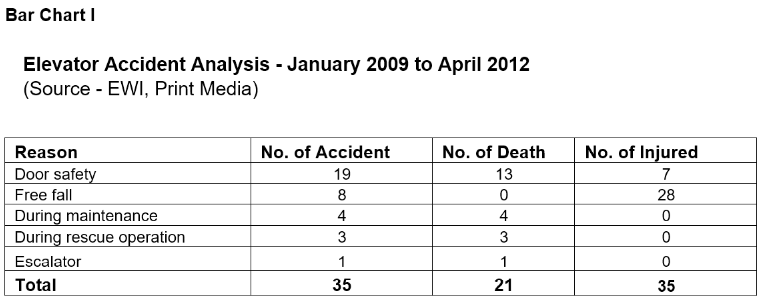

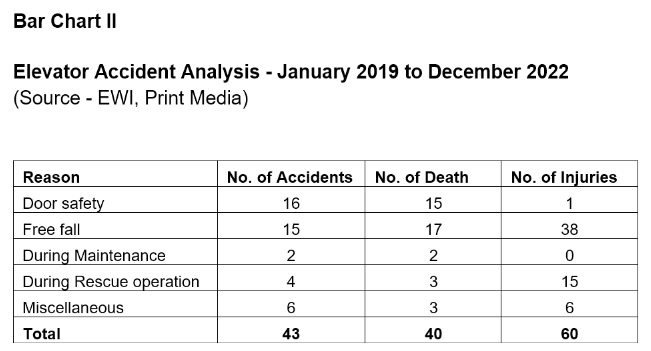

Let us study the accident’s root cause one by one with possible solutions.
1-Door open –
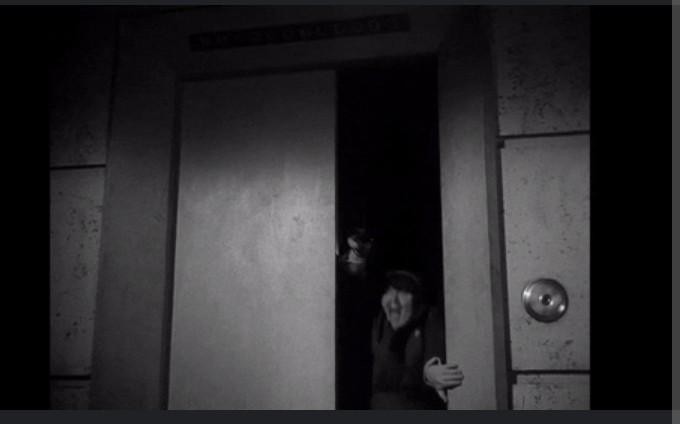
The number of accidents/deaths is higher in Door accident cases as compared to the other failure reasons.
Door accident amounts to 37% of the total accidents. This has gone up from the decade-old data which was reported as 20%.
Let us go into further detail about the failure causes.
Door lock shortening or contact failure is the most common cause of accidents.
There are proper and enough systems for door locks. It has mechanical as well as electrical locking. Moving the elevator with the door open condition is not at all acceptable. The service provider can be treated under the “attempt to murder clause” in such cases.
But there is another way of looking at it. When we enter the elevator, do we check before stepping ahead that the elevator cabin is there in front of us near the floor level.? The number of accidents shows that the passengers try to enter the lift cabin without ensuring whether the cabin is there in front of them or not.
There was an accident in Bandra where a school principal walked into the lift busy reading the newspaper and fell into the lift well as there was no lift cabin on that floor.
His slight alertness could have saved his life.
In a similar accident, a passenger opened the lift door and entered inside. There was no lift cabin. The cabin came down from the upper floor and crashed into the doctor inside the lift well.
We can think of adding one more audio-visual warning on the floors which should activate whenever someone tries to enter the elevator, in the absence of an elevator on that floor. This can be worked out by providing a sensor on the top near the entrance and one inside the shaft to sense the cabin’s presence. Whenever anyone comes near the door, the sensor on the floor will get activated and in case, if the elevator cabin is not there on that floor, another sensor will activate the alarm. Let the design people study the same and work out some effective feasible solutions. This itself is a new topic for research.
Can this be taken as a technical failure?
In the first place, yes, but if we go into the root cause analysis, we will conclude that this is purely because of human error.
The door locks, contact or mechanism has its own designed life. We need to follow the system of checks and cross-checks at prescribed intervals. The preventive system plays a great role in minimizing similar accidents.
2-Free fall-
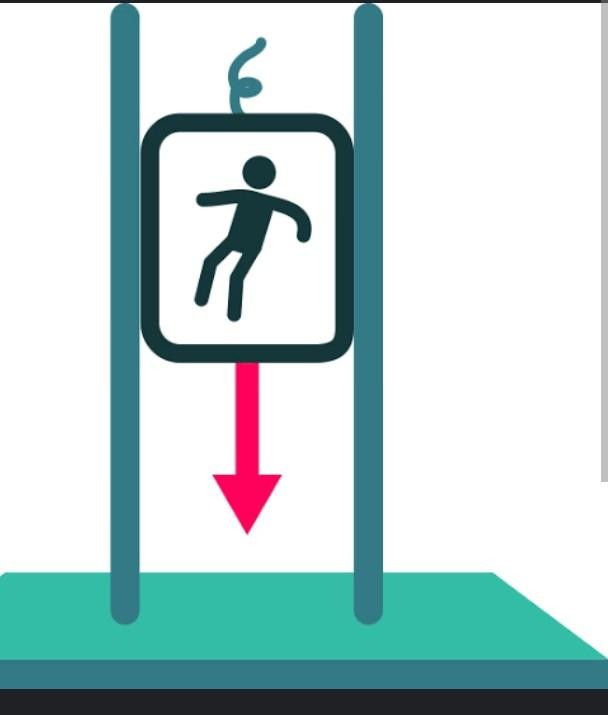
Free fall again is a vague reason for failure or accident. There can be many reasons for an elevator to come down suddenly, without any control.
The data analysis shows that the number of free fall accidents has been around 35% in recent years, which is much higher than the decades-old figure of 22%.
The possible reasons could be –
a-Pulley groove worn out,
b-Reduction in rope diameter over some time,
b-Brake failure,
c-Rope broke including governor rope,
d-Drive feedback circuit failure.
Out of these four reasons, the first two reasons “the pulley groove and reduction in rope diameter “are very common for such failure.
The replacement of pulley or rope is avoided/neglected generally until and unless some authority or auditor or the service provider himself emphasizes this issue.
All these reasons can be well controlled by timely maintenance and adjustment by trained persons. This is well within the control of the service providers.
In addition to controlling the impact of sudden falls of the elevator cabin, spring buffers are provided in the elevator pit. The cabin comes down and rests on buffers with some spring effect. During this period passengers get hurt because of sudden jumps felt in the cabin. This jumping effect can further be reduced if hydraulic buffers are used in place of spring buffers. The hydraulic buffers will provide gradual stooping of the cabin and the problem arising out of jumping effects can be easily avoided. Oil buffers are used in elevators having a higher speed of 2.5m/sec and above.
3-Rescue operation-
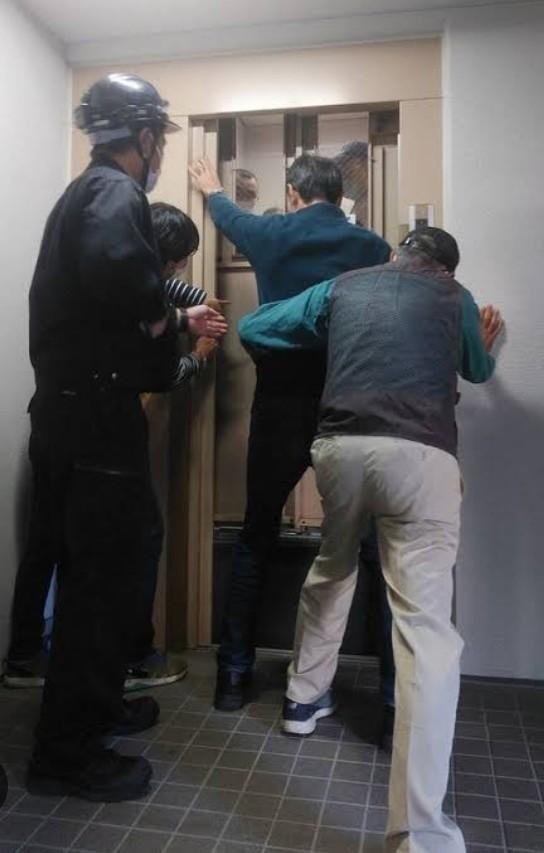
In case of any failure, the elevator gets stopped. This results in Passenger trapped conditions and is very common.
But what is important here is not the passenger trapped situation, but most importantly, how they are rescued?.
Most of the rescue operations are taken up by untrained or less informed persons and this results in accidents or major losses.
The best way to control such accidents is to keep some occupants/security staff/society committee members as volunteers who are given required rescue training by the service provider.
The number of accidents during rescue operations is around 9% which is more or less the same as the old records. This is in terms of the percentage of installation and can be taken as a good sign.
4-Maintenance work-
The accidents which take place during maintenance work resulting in injury or death of service technicians are the result of
a-Lack of training for the technicians,
b-Careless approach by the technicians,
c-Excessive workload or Overburden,
e-Use of improper tools,
d-Shortcut approach.
This is purely in the service provider’s domain.
However, there is considerable improvement in the number of accidents taking place during maintenance work.
If we go into further details of the accidents we will notice a few similarities-
a-In most of the cases, the elevators were under a maintenance contract with a small unorganized service contractor.
b- Most of the accidents were reported from SRA buildings, Housing board buildings, or Tenant buildings. There was a request letter from the Chief Electrical Inspector to the C.E.O. of S.R.A. Projects that there is an urgent need for stringent safety standards regarding the design and construction of elevators/lifts in S.R.A. buildings.
He emphasized an urgent need for stringent safety standards regarding the design and construction of elevators/lifts in S.R.A. buildings.
In percentage terms, the present accidents are around 5% as against earlier records of 11%.
5- Miscellaneous-
This accident category includes accidents because of rope breakage, brake failure, control failure, or any other part failure leading to the death or injury of the passengers.
This accident can be easily avoided by taking service activities seriously, and repairing or replacing the parts before it leads to major failure or accident. Like the breakage of rope cannot happen in one day. It may start showing stand breakage and ultimately lead to rope breakage over some time. The Service technician can not overlook such issues. He needs to be more careful and vigilant.
These accidents are around 14% of the total accidents reported presently.
From the above statistics, one can easily conclude that the number of accidents and passenger deaths, in absolute terms, is increasing even after many improvements in elevator systems and procedures.
This makes us rethink our elevator safety systems, training, rules and procedures, checks and cross-checks.
The reports appearing in the media are, most of the time, not clear and do not help industry experts understand the exact cause of failure/accident. If each accident is explained in detail and studied in depth, it can be of great help to industry experts to pinpoint the cause of failure. This will also help the authorities in redefining our system and procedures and minimize accidents and losses.
There may be a few more accidents that might have not come into the media knowledge. But we have to go with the data available through authentic sources.
The accident records forced us to find suitable answers/solutions to the questions raised here, which are dealt with in detail in the concluding section of this report.
Conclusion:
Let us analyze the number of death and injuries and their percentage in each category of the accident. This comparison is prepared to understand the percentage of deaths and injuries in each category of accident separately and not in terms of overall elevators population.

From the above chart, we can easily conclude that the death percentage is higher in the case of door safety, free fall, and maintenance. Whereas the death percentage during rescue operations and miscellaneous categories is slightly low. This can be termed as an accidents due to negligence or human error.
We need to focus more on accidents due to door safety, free fall, and maintenance issues.
The possible solution or action required is explained here for the benefit of the Industry and Government Authority.
1-Awareness among users –
It is noticed that in most cases deaths or serious injuries are reported because of a lack of awareness regarding elevator safety and rescue procedures.
The trapped passengers panicked and the person present outside without knowing the rescue procedures tried to help the trapped passengers.
We need to educate the users that as long as they are inside the elevator and not trying to come out till the elevator is brought to the nearest floor level, they are safe. This procedure takes 5-10 minutes only. The only time taken by the service technician to reach the site is not certain. It all depends upon the time taken by him to reach the spot. All this depends upon his location, mode of travel, and local traffic conditions.
The persons available outside the elevator need to update the trapped passengers about the action taken and provide moral support till the technician reaches the site.
2-Rescue training –
The analysis confirms that we still need to create awareness among the users and increase the frequency of safety training and rescue training for the security staff and service staff. Create volunteers in society and provide them required training.
The licensing authority can work out a suitable module where the volunteers are provided a short-duration practice training and are awarded a certificate for the same.
Even the licensing authority can think of authorizing service providers to take up the responsibilities of training and issuing certificates to the society office bearers and security staff.
3-Introduction of uniform lift rules all over the country and their monitoring –
All the Indian states need to have their elevator inspection departments. At present only 11 Indian States /UTs require lift licenses which include Maharashtra,Gujarat, Jharkhand, Tamil Nadu, Karnataka, Kerala, West Bengal, Assam, Himachal Pradesh, Haryana, and Delhi. Other states still have to introduce a structured procedure for getting the operating license, monitor the elevator activities, and provide guidelines for the users as well as suppliers.
The data reveals that the deaths due to elevator accidents are mainly reported from elevators maintained by freelancers / unorganized sector, irrespective of their make. This leads us to work for an effective and feasible method for providing training, creating awareness, and introducing checks for this unorganized sector.
Introducing safety audits by qualified/certified auditors can play a great role in improving the safety and reliability of the system.
4-Introducing additional safeties –
The majority of the accidents are reported because of free falls and door-open conditions. There are a few suggestions to minimize these failures and losses.
- Providing hydraulic buffers for all elevators can reduce the accidents/losses faced because of sudden falls / free falls of elevators.
- Working out for a sensor to detect the presence of the elevator cabin and provide a warning in case of door opens. This can help in reducing accidents because of door open issues.
5-Addressing unorganized sector issues –
Societies need to save money to meet the high service charges of Organised players. The organized sector should work out some long-term plan so that the elevator remains with them for a longer period, if not for its life cycle.
Maybe offering a service contract with the initial lift supply order for 10-15 years or a lift life cycle can make a good change.
The expenses towards major repair or modification must be considered under the building repair activities and the society must be allowed to utilize the money from sinking funds towards this work.
Societies must take proper care while selecting the service provider. Particularly in the case of going for the unorganized sector, one must go into the details of the agency, its service setup, competency, financial status, and records.
6-For the Government authorities and Policymakers –
From the latest accident records, we can easily point out the area where more action or attention is required.
- Sra building lifts accident 7 accidents out of a total recorded 43 which comes to 16% whereas 10 deaths out of a total 40 which comes to 25%.
- Unorganized sector – Almost all the elevators where accidents/deaths are reported are maintained by small, unorganized service providers, irrespective of the make of the elevator.
- Accidents in states where lift rules are not there. Out of 43 accidents 10 accidents are reported from the states where lift rules are not implemented. Which comes to around 23%. The death records in these cases count to 12 deaths out of 40 deaths. This is nearly 30%.
The industry is constantly working for the safety of the users and the reliability of the equipment. The latest IS17900 part 1 & 2 with many changes, is in the pipeline and may be available for the benefit of users and the industry at any time.
I am sure this analysis will help the Government policymakers and Elevator Industry to take the required corrective measures to make the system more effective and reliable to reduce the overall losses due to elevator accidents, ultimately heading towards “Zero death in Elevator accidents“.





